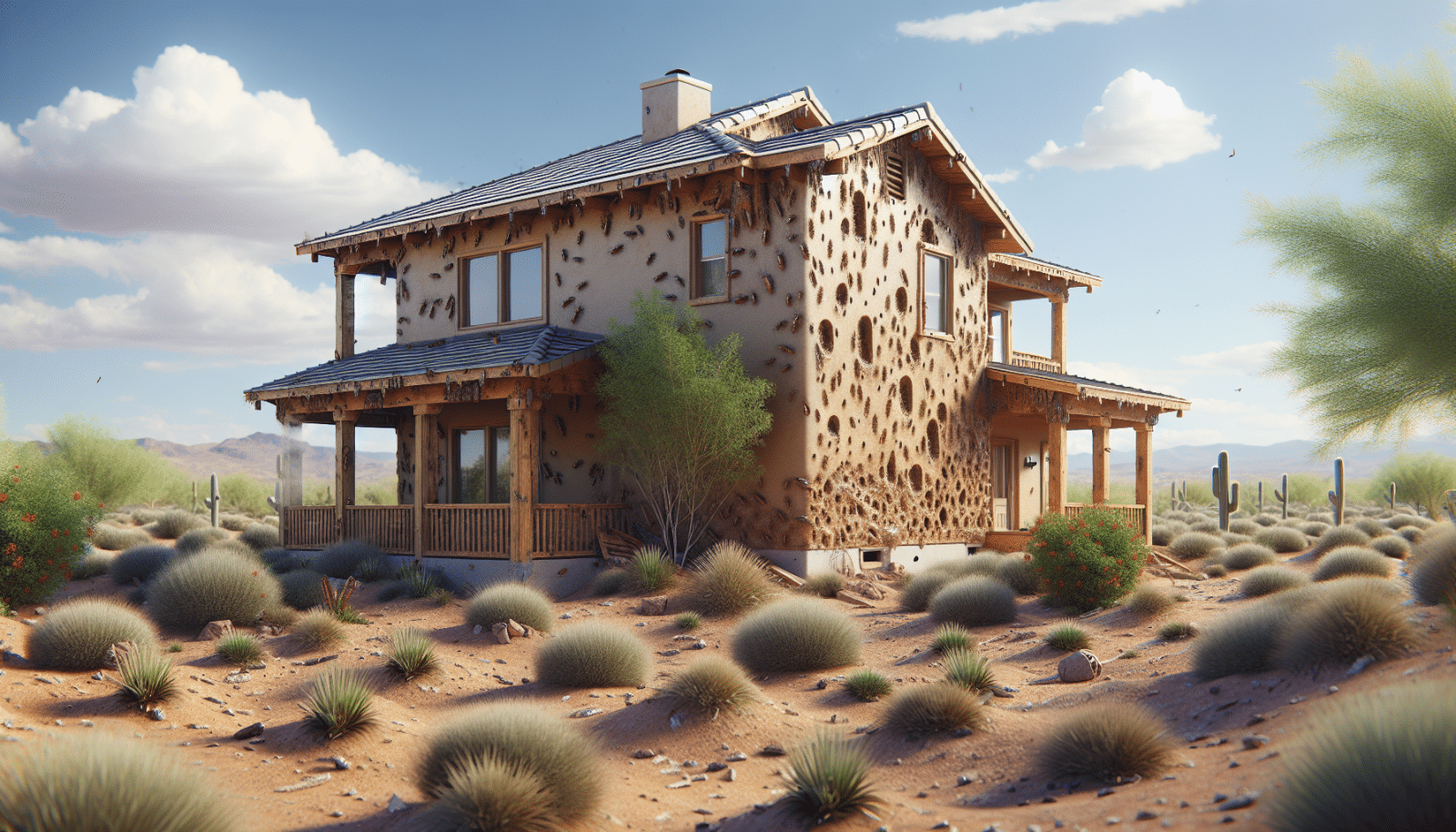At Arizona Termite Control, we understand how disruptive and damaging a termite infestation can be. As homeowners ourselves, we know the importance of early detection in keeping your sanctuary safe. Luckily, this article will guide you through spotting the early signs of termite trouble, so you can act quickly. This guide is tailored to homeowners like you, ensuring your home remains protected and termite-free.
Contents
- 1 Understanding Termites
- 2 Common Types of Termites
- 3 External Signs to Look For
- 4 Damaged Wood
- 5 Frass: The Tell-Tale Droppings
- 6 Wings: A Sign of Swarmers
- 7 Tight-Fitting Doors and Windows
- 8 Clicking Noises
- 9 Common Hotspots for Termite Activity
- 10 How to Prevent Termite Infestations
- 11 Why Professional Inspection Matters
- 12 Contact Arizona Termite Control
Understanding Termites
Termites are more than just Pests; they’re silent destroyers of your home’s structure. These tiny insects feed on cellulose, which can be found in wood, paper, and other plant-based products. They often go unnoticed until significant damage has occurred.
The problem lies in their stealthy nature. Termites can intrude your home without making a sound or leaving obvious signs at first. That’s why arming yourself with knowledge about their habits and early warning signs is essential.
Common Types of Termites
In Arizona, you are most likely to encounter two types of termites – Subterranean and Drywood termites. Subterranean termites nest in the soil, creating mud tubes to access wooden structures, while drywood termites nest directly within the wood they infest.
Knowing the specific type of termite infesting your home can help in determining the most effective Treatment methods. Each type requires a different approach for eradication and control.
External Signs to Look For
The exterior of your home can harbor the first signs of an infestation. Noticing these signs early on can save you headaches and repair costs.
Keep an eye out for mud tubes along your home’s foundation. These small, pencil-width tubes are used by subterranean termites to travel from their nest to their food source. They provide protection against predators and dry air.
Damaged Wood
Termites love to feast on wood, making it crucial to inspect any wooden structures regularly. Tap on the wood; if it sounds hollow or you notice tiny holes, termites might be at work.
Additionally, peeling paint or walls that appear damp can indicate termite activity. Termites introduce moisture into wood, causing the paint to bubble and peel.
Frass: The Tell-Tale Droppings
Drywood termites often leave behind something called frass – small, wood-colored droppings. Finding frass is a clear indicator of an active infestation. These droppings are usually found near the entry points of the termites, such as window sills and door frames.
Remember, these pellets are very tiny, almost like sawdust, so you might need a keen eye to spot them. Always investigate any unusual wood debris in your home.
Wings: A Sign of Swarmers
Termite swarmers are reproductive termites that fly out to start new colonies. They shed their wings after landing. If you find discarded wings around your windowsills or floors, it’s time to be concerned.
Swarmers might not cause damage directly, but their presence inside your home suggests an existing colony nearby or within your structure. Early detection is crucial during this phase.
Tight-Fitting Doors and Windows
Has your door or window started getting stuck for no apparent reason? It might be termites. Termite damage and the resulting moisture can warp wood, causing tight-fitting windows and doors.
Pay attention to these subtle changes. If your doors and windows are harder to open or close, it might be more than just humidity.
Clicking Noises
Termites are surprisingly noisy eaters. If you press your ear to your walls and hear clicking noises, it could be termites chowing down on your wood. Soldier termites will bang their heads against the wood or shake their bodies to signal danger to the rest of the colony.
Regularly listen for these noises, especially during the quiet parts of your day. Early detection can make a big difference in treatment success.
Common Hotspots for Termite Activity
Not all areas of your home are equally at risk for termite activity. Here are some common hotspots:
- Crawl spaces: Located underneath your home, these spaces offer termites easy access to wooden structures and are less likely to be disturbed.
- Attics: With less traffic and ample wooden materials, attics can become prime spots for drywood termites.
- Foundations: Subterranean termites often build mud tubes along foundations for easy access to wooden support structures.
- Wooden decks: Constant exposure to weather conditions and less frequent Inspections make decks susceptible to termite attacks.
- Fences: These structures are often overlooked but can provide an easy pathway for termites to enter your home.
How to Prevent Termite Infestations
Being proactive can save you from future infestations. Start with regular inspections and keep an eye out for the early signs mentioned above. Furthermore, ensure your home is less inviting to termites by reducing moisture levels and eliminating wood-to-soil contact.
You can also consider professional pest control Services for regular monitoring and preemptive treatments. This investment can safeguard your home from costly repairs in the long run.
Why Professional Inspection Matters
While DIY checks are essential, professional Termite Inspections can provide peace of mind. Experts like us, at Arizona Termite Control, use specialized tools and knowledge to detect hidden infestations that are easy to miss.
Professional inspections not only confirm the presence of termites but also help you plan a suitable treatment strategy. Timely intervention can make all the difference in protecting your home.
Contact Arizona Termite Control
Don’t let termite trouble ruin your peace of mind. Contact Arizona Termite Control today by phone # 480-660-3093 or Request a Free Inspection. We’re here to help!




